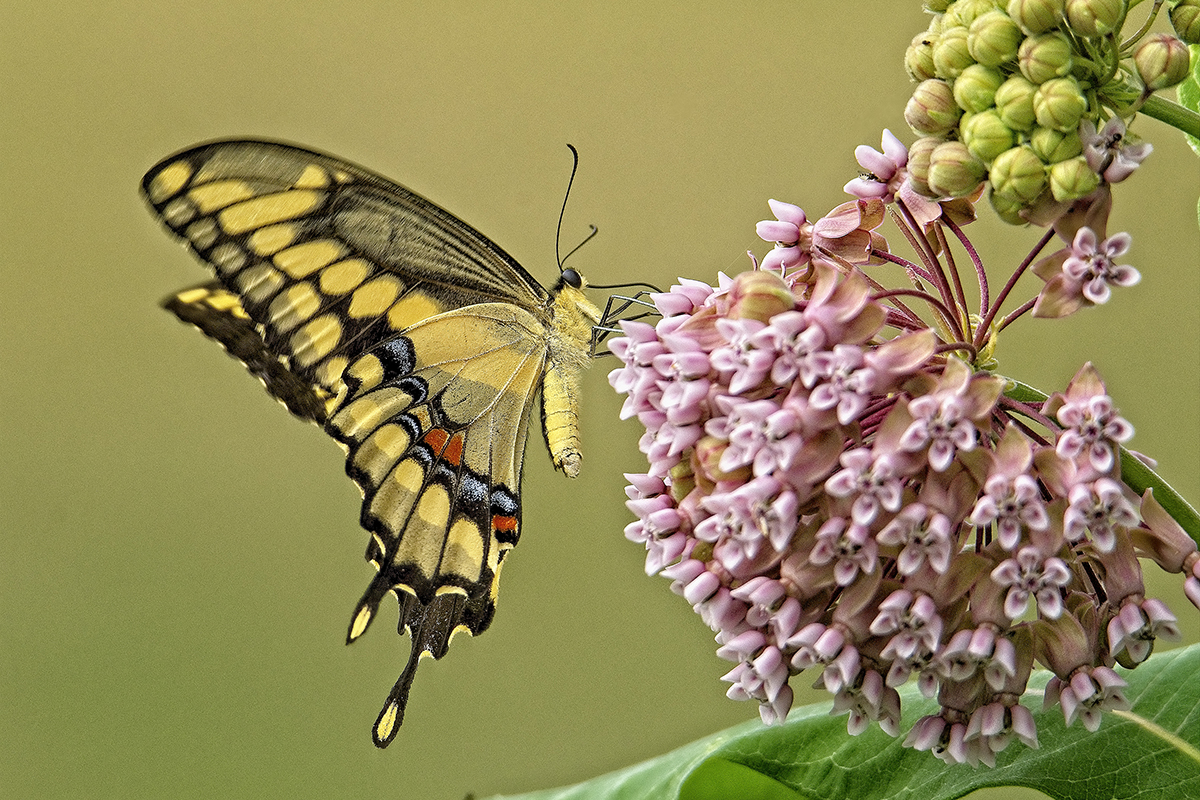Canada’s Huck Finn, Behind the Camera
Antal Kozma explores the Ontario wilderness with the Tamron SP 150-600mm VC G2 lens.
More Photo Tips | Video Gallery | Photo Gallery | Enewsletter sign-up
By Jenn Gidman
Images by Antal Kozma
Antal Kozma was first drawn to creating pictures as a young teen, when his photographer uncle would let him hang out in the darkroom. “By the time I was 16 or 17, I was a full-fledged photographer myself,” he says. “As a teen boy, I appreciated the mathematical side of photography, as well as the artistic aspect.”
He was also influenced by Mark Twain and was fascinated by Huckleberry Finn and Tom Sawyer’s adventures outdoors. “My father was an avid fisherman,” he says. “I grew up along a river and swam like a fish. I’ve always been connected with Mother Nature.”
Today, Antal merges that love of photography with the great outdoors via his nature and wildlife photography, enjoying his retirement years exploring the parks and preserves near his home in southwestern Ontario and serving as an advocate for nature conservation. “Fortunately for me, two of the best birding hot spots in Canada are within a short driving distance, including Point Pelee National Park and Rondeau Provincial Park,” he says. “People come from all over: Delaware, Southern California, the UK, you name it. Beginning next month, which is the start of birding season, I’ll be out three or four times a week taking pictures in these places. I also enjoy traveling to British Columbia to photograph other wildlife like cougars and grizzly bears.”
Having the Tamron SP 150-600mm VC G2 ultra-telephoto zoom lens on his camera offers Antal the versatility to photograph everything from a close-up of native flora to a bird or bear in the distance, all safely and without interrupting the animal’s routine. “I shoot a lot in marshes and bogs, where a duck will suddenly show up in the bulrush,” he says. “I like having the flexibility to zoom in and out without having to change lenses to capture anything that pops up out of the blue. The 150-600mm’s autofocus is so fast, and the Vibration Compensation feature is awesome, since I can’t have a tripod in the marsh—I need extra help getting rid of camera shake. I can’t believe the handheld shutter speeds I’m able to achieve with the VC.”
When he’s out in nature, the compositions for Antal’s photos often come to him instinctually, based on years of experience behind the camera. “I just see the scene and know how to frame it,” he says. “With the 150-600mm, you have to be loose and go with the flow. If a bird lands in a particular spot, you may not have a chance to create an elaborate composition before it flies away. This lens allows me to shoot spontaneously and still get creative with how I present what’s showing up in front of me.”
Here, some of Antal’s recent photos in the Great White North, all taken with the 150-600mm lens.
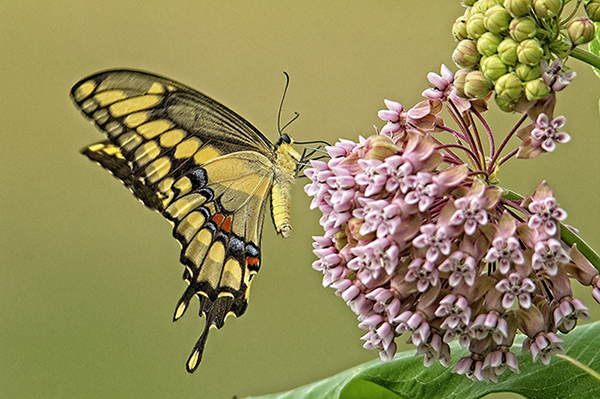
150-600mm (500mm), F/8.0, 1/640th sec., ISO 800
Click image to view larger
Being the nature person I am, I love gardening. I took photos of this butterfly about 20 yards from my home, in my own garden, where I plant milkweed, which is extremely important for monarch butterflies. Swallowtail butterflies like this one also are drawn to milkweed. When I’m home, I always have a camera nearby with the 150-600mm on it in case I spot one, because with this lens’s magnification ratio and Vibration Control feature, it’s perfect for creating close-up or semi-close-up images of this kind of large butterfly.
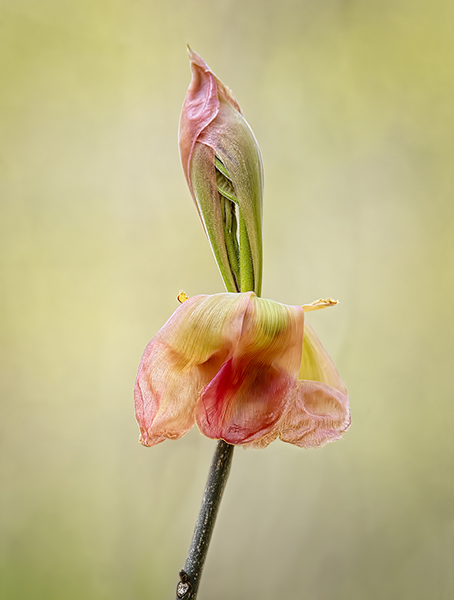
150-600mm (300mm), F/8.0, 1/640th sec., ISO 800
Click image to view larger
I was on a trail trying to find a yellowthroat warbler when I came to a small opening, with this tiny single flower on a twig that was about 5 feet tall. It was the new shoot of a hickory tree. The sun was creating this soft, diffused, yellowish-green background on the leaves in the distance, which worked perfectly for this type of picture to complement my subject. Because it was just a solitary flower, I didn’t want to use the rule of thirds or any other photographic standbys—I simply centered the flower in the frame. I ended up enlarging this photo to a 24-by-30 and have it hanging in my small private gallery at home.
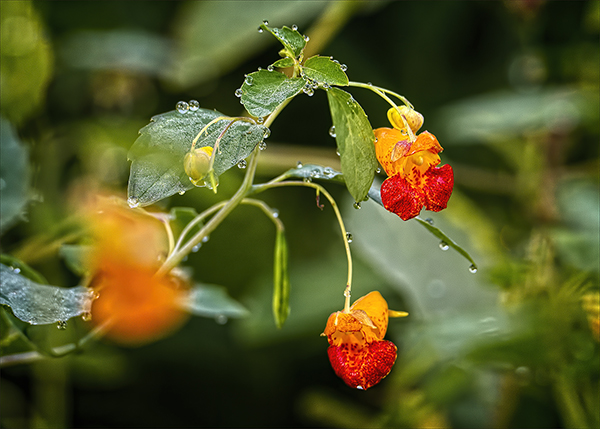
150-600mm (460mm), F/8.0, 1/160th sec., ISO 400
Click image to view larger
This is a touch-me-not plant, which I photographed in the early morning in diffused light deep in the woods. The dewdrops on it is what makes the image. I took this vantage point, where you see that blur of orange-yellow in the lower left, not to make a clinically clear photo where everything is in focus, but to add something visually interesting in the frame. I don’t think it distracts from the two sharper flower heads in the foreground, and it makes the photo a bit more vibrant and balanced. I shot it at F/8 because I wanted to show both of the flower heads and the edges of the leaves, which were holding those dew drops, as sharp as possible.
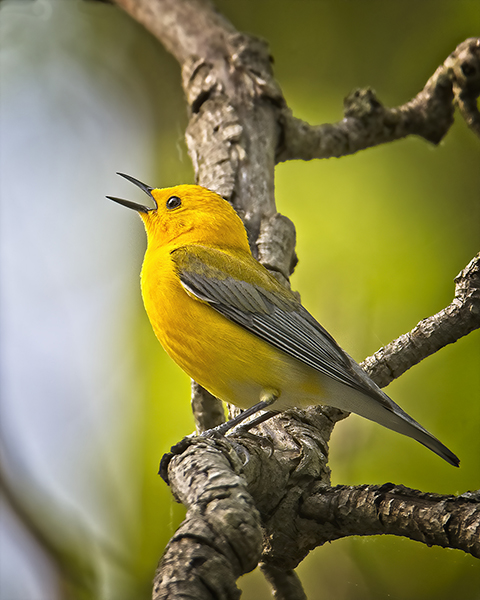
150-600mm (600mm), F/8.0, 1/320th sec., ISO 400
Click image to view larger
Warblers are hard to find and hard to approach, because they like being high up in the canopy, singing like crazy. Once in a while, though, you’ll see a spot of yellow darting through the trees, so you have to grab any chance you can to take their picture. I usually need to photograph these birds at 600mm because they’re so high up—and even in this photo, the image is still cropped a lot. The bird was chirping on that branch for at least four or five seconds, so I was able to capture a good number of photos.
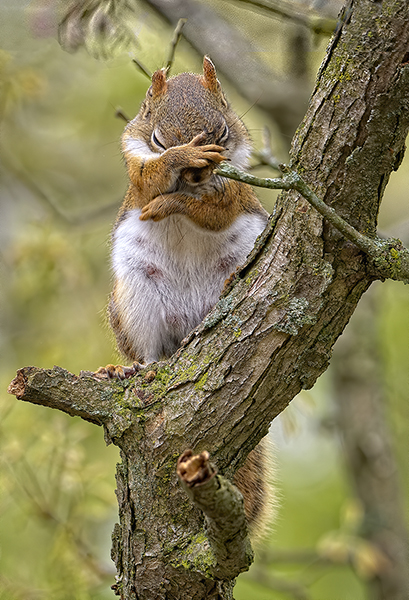
150-600mm (380mm), F/7.1, 1/500th sec., ISO 800
Click image to view larger
I love this photo. This squirrel looks ashamed of something. It obviously has a family, because you can see on its chest that it’s a mother who’s nursing. Again, there’s diffused light, with no concerning shadows in the image. I needed a higher ISO for this photo, and the Vibration Compensation on that 150-600mm lens came in especially handy.
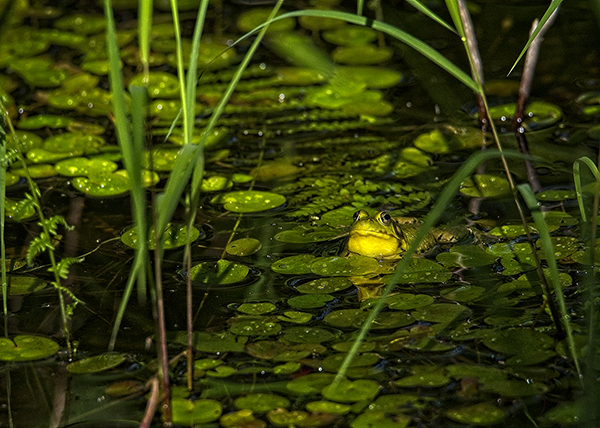
150-600mm (600mm), F/7.1, 1/2500th sec., ISO 1600
Click image to view larger
The frog photo was taken in direct sunshine. I was searching for warblers to photograph, but they weren’t cooperating, so I was keeping an eye out for anything else I could take pictures of. The early morning sun was filtering through the trees and creating this spotlight in the marsh. I spotted the droplets on the leaves in the water and thought: Wouldn’t it be great if a frog showed up right around now? Frogs like warming their bodies in the sun, so I knew there was a good chance one might show up, and sure enough, this one soon did. I took this photo at F/7.1 because I wanted to achieve a zone of sharpness that showed a couple of rows of the leaves with the droplets on them.
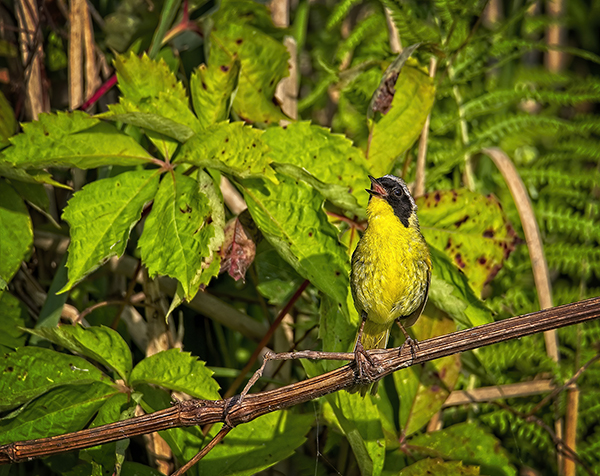
150-600mm (600mm), F/8.0, 1/500th sec., ISO 400
Click image to view larger
This photo of a common yellowthroat warbler was taken along a boardwalk at Point Pelee National Park. I know in the early morning light, these warblers will eventually show up at this favorite spot of mine after 15 minutes or so, because it’s just an ideal place to warm up first thing in the morning. This guy showed up and started singing. The leaves behind it were very close to the vine the bird is sitting on, so I couldn’t exclude those, even shooting at a lower aperture. I didn’t mind it, though, because it offered a pretty green frame for the bird.
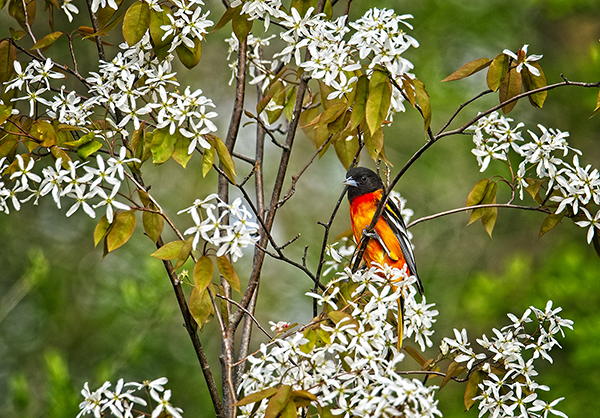
150-600mm (500mm), F/7.1, 1/400th sec., ISO 160
Click image to view larger
This photo was taken in Rondeau Park, during spring migration time. This spot isn’t too far from the visitors center, where they have feeders set up for the orioles. You’ll see lots of people zooming in on the feeding area to capture pictures of the orioles, but I didn’t want the plastic feeder in my image. Instead, I saw this flowering shrub nearby and figured that, eventually, one of the orioles would land there. My wish came true. It took about five minutes before the oriole turned its head just the way I wanted it, so I could capture that little sparkle in its eye. So much about photography depends on patience, and waiting for that right moment.
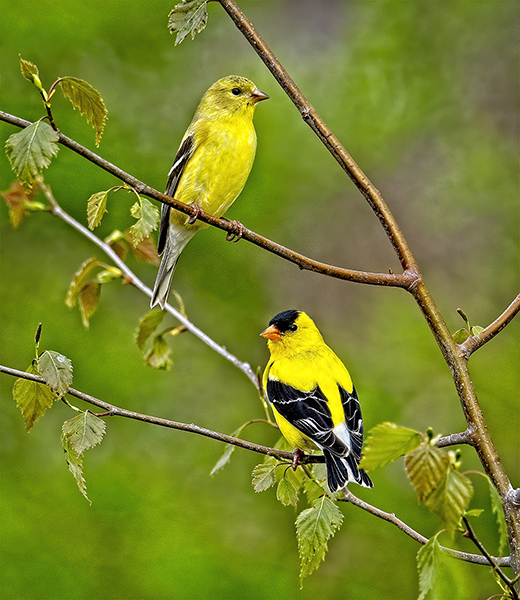
150-600mm (460mm), F/7.1, 1/400th sec., ISO 320
Click image to view larger
Speaking of patience, this image of two American goldfinches was the fruit of just that. I took about a dozen photographs of them, and this is the only one where the position of their heads was suited for the picture; in the other ones, one was looking this way, the other was looking that way, and it wasn’t visually appealing. I took this photo at F/7.1 to get the necessary depth-of-field—the male bird on the bottom branch is slightly set back compared with the female bird higher up, so I didn’t want to risk shooting at F/6.3. I had to do a little adjustment in post-processing to make the female bird a bit sharper.
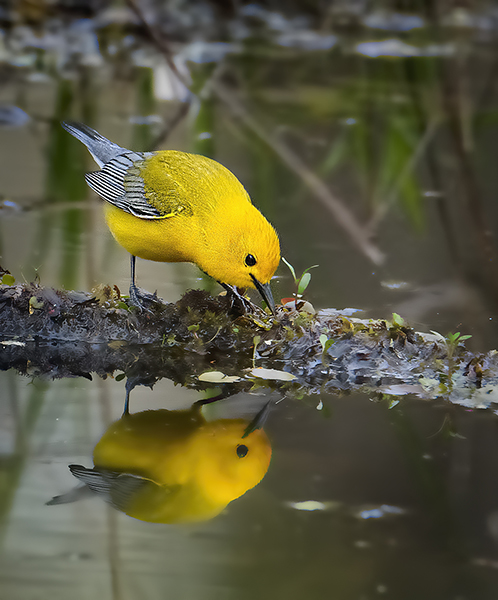
150-600mm (600mm), F/7.1, 1/400th sec., ISO 2540
Click image to view larger
This photo was taken the same day as the two finches. This was a very difficult situation, because it was already dusk and I was in dense woods, so I ended up using Auto ISO for this photo; it shot up to over ISO 2500. I had to lift the shadows a bit because it was about a half-stop underexposed.
To see more of Antal Kozma’s work, go to https://naturephototrail.com.
More Photo Tips | Watch Videos | Learn More About Tamron Lenses | Photo Gallery
